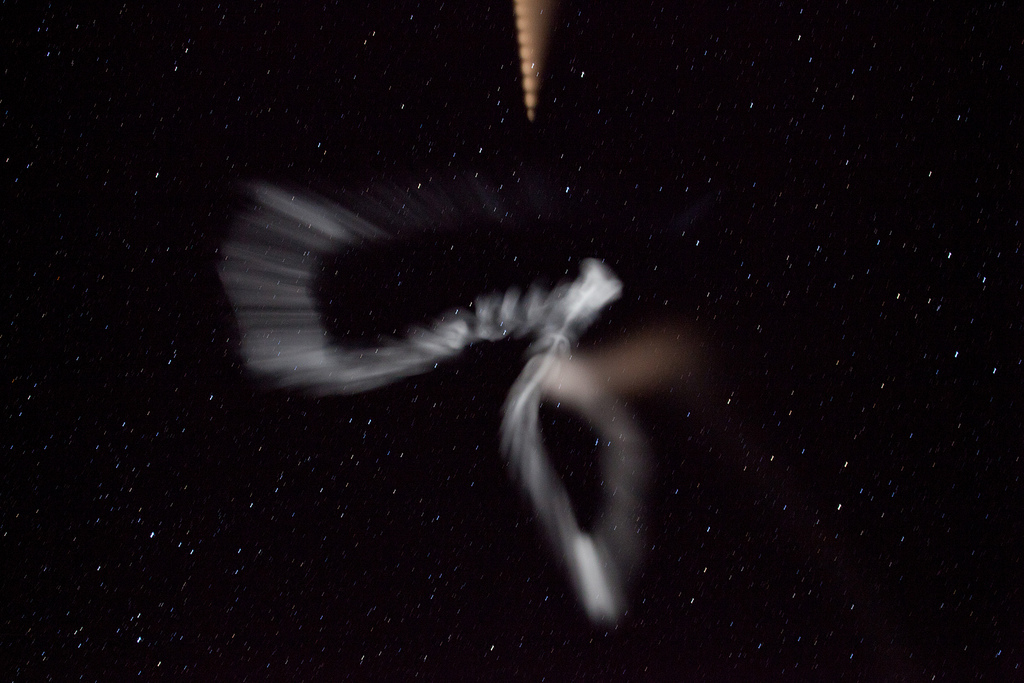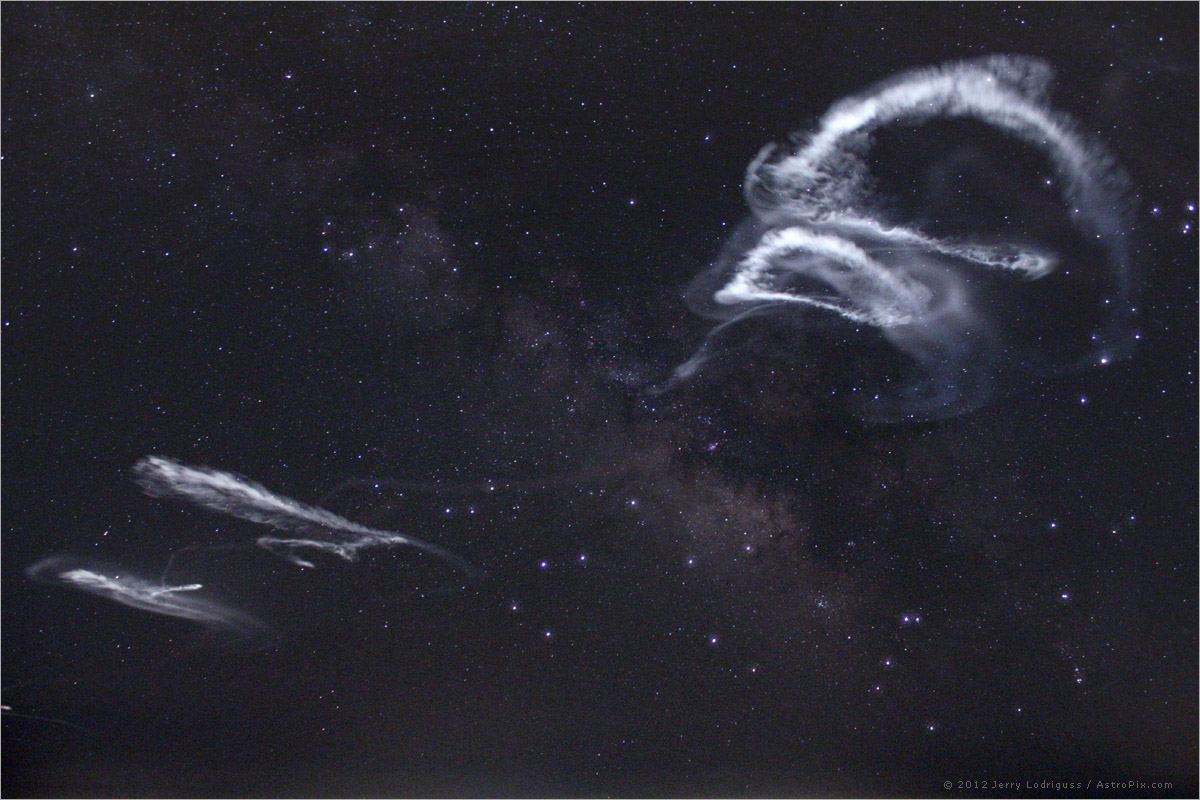Launch Madness: NASA fires 5 rockets in 5 minutes. Two days ago, 5 ATREX sounding rockets were fired from NASA’s Wallops Flight Facility in Virginia as part of a heliophysics study of the upper level jet stream.
• At the edge of space, 60 to 65 miles above Earth’s surface, winds achieve astonishing speeds of 200 to 300 miles per hour. This highly electromagnetic layer can damage man-made satellites and disrupt communications systems.
• Each rocket released a harmless chemical tracer, trimethyl aluminum (TMA), which forms milky, white clouds that track the winds in space. In addition, two of the rockets carried instrumented payloads to measure pressure and temperature during their short flights.
• “This area shows winds much larger than expected,” says Miguel Larsen, a space scientist at Clemson University who is the principal investigator in charge of these five rockets, known as the Anomalous Transport Rocket Experiment (ATREX). “We don’t yet know what we’re going to see, but there is definitely something unusual going on. ATREX will help us understand the big question about what is driving these fast winds.”
Sources: http://www.nasa.gov/mission_pages/sunearth/missions/atrex-nightlight.html
http://apod.nasa.gov/apod/astropix.html





I live close by and am annoyed that I missed the launch..they postponed it for more than a week due to weather related issues and the day I forgot to check, they launched 😛
Forgive me for being thick, but how is it this is only being explored and discussed now ? We’ve certainly gone through this (in both directions), and I don’t recall any issue being raised.
Very nice, I love the photos thanks. There is a photo from NASA’s flickr stream here that I liked. http://www.flickr.com/photos/gsfc/7020702697/ looks like fireworks a bit.
And some footage released and posted from the launch, if anyone might be interested.
http://www.nasa.gov/mission_pages/sunearth/missions/atrex-launches.html
I was wondering about that too, Gnotic Pasta ! William McGarvey , I guess the experiment is being done because someone was able to successfully propose the project and it get funded? I’m not sure what other reason there could be.
Thanks for linking to the Flickr source, Rich Pollett …that was indeed from where I downloaded these photographs 🙂
Rajini Rao Ah, once again — the wonders of peer review!! The prerogatives of program directors!! The N.I.H. model is the “crown jewel”, eh? Hah! If we want fireworks, by golly, we’ll have fireworks…
William McGarvey Actually, NIH peer review is a vast improvement over the politicized and highly complicated NASA funding system (my husband works on NASA funded projects). Their priorities seem to change at the same speed of the jet stream winds. The review seems heavily administrative and not at the same level of scientific peer rigor, from what I hear. Hate to admit, but I kinda like the NIH system 🙂
Rajini Rao I’m sort of teasing my old employers of over 18 years, and sort of being serious. Yes, other agencies have sent their folks out to copy the NIH peer review system because it may be the best the government can offer — but it’s not without its problems, and broad professional confusion about its machinations. A topic comes to mind: scoring and success in funding.
Many have professed confusion over the relationship between and among priority scores, percentile ranks and funding level. In practice, this confusion arises because the three are assumed to be highly (if not perfectly) correlated — not only with one another, but most critically with an ultimate funding decision.
But priority scores (intended to be somehow ordinal in nature, and hardly ever Gaussian in their distributions) are accorded a fallacious precision suitable only for interval level data. (And according to a study I once did, the judgments of two, and possibly three reviewers — not the entire group — account for the greatest proportion of the variance in the assignment.)
Once assigned, the percentile rank accorded to precisely the same priority score may vary greatly — not only across study sections but within a study section over time. (Note, too, that several schema are arbitrarily chosen or designated to assign the percentile ranks depending upon the study section.) However derived, an applicant may feel their assigned percentile rank is the most important basis for a funding decision — but it’s not.
Ultimately, after the study section makes its call(s), the real choice for funding depends upon the “program needs” of a given Institute (which may choose to fund “out of order”, thus throwing the peer review results into a cocked hat). These “program needs” are often politically driven, and not necessarily scientifically nor medically-based in practice. So, when an Institute announces that it funded 20% of its applications, there is no assurance that a carefully assigned percentile rank of 15 guarantees funding.
I’ve only skimmed the surface here, but I’ve done so to illustrate some of the flaws in this “crown jewel”.
Interesting and cool ! nice pictures Rajini Rao . Your husband work for NASA, no wonder you’re also interesting in these events even more. My brother works for JPL and he hasn’t told me anything about this at all !
William McGarvey , all very true..no system is infallible but the secret is to understand this process exactly as you have said and make it work. From an investigator’s point, it’s about serving on study sections so that we understand the reviewer’s mind set, understanding the funding priorities of the agency, having good relations with program officials, networking with one’s peers, and so on. It’s a learning process like everything else. Not all scientists study the idiosyncrasies of the NIH system (but they sure do complain), although they ought to!
IMO, the real problem is not with the review system or the NIH itself, it lies squarely with the abysmally low budget that allows only a handful of grants get through. At this extremely low rate (10% success for most NIH institutes), differences between funded grants and those that miss the payline are purely subjective. That is NOT the fault of the peer review system.
For example, re. your funding at 20th percentile reference..I know that because the data on funding success versus percentile ranks are routinely emailed to us by the funding agency (you bet I read those emails!). While 100% of proposals at say 5th percentile will be funded, perhaps 50% of proposals at the 20th percentile will be funded with preference given to new investigators, or program priorities.
Of course, I’m writing from the vantage point of being at a university that is #1 in NIH funding. 🙂
Tom Lee my husband works for this project http://www.goes-r.gov/, scheduled for 2015 launch. Mostly we talk about mundane stuff: what to do about the weeds in the lawn or who is going to the store to buy milk 😛 So I don’t blame your brother!
Rajini Rao Exactly — I know of your institution’s historic prominence in NIH support and its connections to it (like my last Director, Elias Zerhouni), so I dwelt a bit long here for some tastes, I imagine. I’m afraid, though, that there’s a sort of “Parkinson’s Law” ( work expands to fill the time available ) corollary at play here with regard to NIH funding. To assume that greater funding alone will improve success rates assumes that the number of applications will remain constant. I doubt that, but perhaps you mean to assume the number of quality applications will be a constant. Regardless, I think hopes for even sustained NIH funding levels (say, under the Ryan budget philosophy) are at risk. Should the GOP take both Branches and the White House, the risks are even greater.
As you note, though, there is a great deal of “subjectivity” in the NIH decision-making process. Unfortunately (to my way of thinking, at least), what this leads to (beyond a lot of professional and interpersonal politicking and game-playing) is research funding that often goes on for decades . The medical and health benefits to be derived from these efforts often remain so remote that program staff have to scramble annually in preparing their Congressional budget justifications to find examples of just what their Institutes have done for the public’s health. But, these are NIH scientific grants , not contracts with deliverables (which the NIH has, too, but manages even more poorly), and grantees are not required to adduce evidence of their contributions to improvements in the public health. And so it goes, as Vonnegut would have it…
Hopefully, we’ll have a chance to chat again sometime — thanks for putting up with my rants.
Feel free to chat anytime, William McGarvey . I look forward to more insights on that temple to which we researchers show obeisance 🙂
Rajini Rao Great, and thanks. Wait ’til I tell you about my “ten-year clock” concept — it speaks directly to the combined issues of success rates, age distributions, and the scientific personnel “pipeline” — but it’s not something most want to hear about, either within “that temple” or amongst the supplicants. (Now, there’s a tease for you…)
It interesting that this current project is getting so much coverage. It looks like Miguel Larsen’s projects. He’s been launching TMA rockets for at least 10 years that I know of but this is the first time its gotten so much coverage.
Sloan Lindsey , interesting perspective, thanks! Yes, it is indeed Dr. Larsen’s project (see quote in the post above). I wonder if there is something special about this project or if it just got written up and featured on the NASA page for a change. Perhaps Clemson university published the news on their site and it got picked up?
Gnotic Pasta : Your comment yesterday nudged me to look up the structure of TMA (because the acronym is better known as tetramethylammonium ion in the neuroscience field where it is a potent ion channel blocker or even trimethylamine of infamous fishy odor). Thank you for the contribution of the word pyrophoric to my chemistry lexicon 😉
If yer gonna launch, you might as well blow off more than one!!
Timing is everything, Jeffrey J Davis 😉
Rajini Rao and location, location, location, location, location… winks
Of course, that too William McGarvey 🙂
This looks dramatic to me